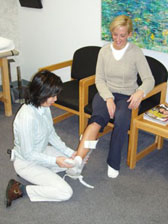Once you have your prescription in hand and come in for your initial appointment, a BioMetrics ABC Certified practitioner will discuss your needs with you and your physician to determine which type of brace (orthosis) best meets your functional needs.
Orthoses cover a wide range of needs, so there are many types of orthotic products available. While prosthetics are always crafted for each patient, orthoses serve a different function so in some cases “off the shelf” or ready-made braces will do the job. If an “off the shelf” orthosis is recommended, it may be available that same day. Others braces may need to be ordered and fit at the next appointment.
If a custom fabricated orthosis (brace) is recommended, one of the following measurement techniques will be used: Hand measurement, hand cast, or CAD (computer aided design).
Here is how we fabricate a custom orthosis.
 Step 1:
Step 1:
Once we know a patient requires a custom orthosis, a cast is made that allows our technicians to create a brace that is designed specifically to meet your requirements. This is done by using either plaster or fiber glass casting material.
 Step 2:
Step 2:
The cast created in Step 1 is filled with medical plaster to create a positive mold, or an exact reproduction of the part of the body in need of a brace. After analysis, the mold is modified and fine tuned for pressure points and skeletal irregularities to create a fit that will create the needed result.
 Step 3:
Step 3:
Once the positive mold is finished, a plastic sheet is heated and draped over the mold. It is then vacuum formed onto the mold so it takes on the exact shape of the patient’s limb or area in need of the brace.
 Step 4:
Step 4:
Once the plastic mold cools, it is cut off the form. Any rough edges are smoothed out, and if necessary straps and/or pads are added.
 Step 5:
Step 5:
We always emphasize the importance of good communication between patient and staff to ensure the best possible outcome and that is especially true in this stage: the final fitting of the new orthosis. Your orthotist will complete a careful examination and take the time needed to ensure the fit will be problem-free and therapeutic. Final adjustments are made and then the orthosis is ready for use as prescribed.
